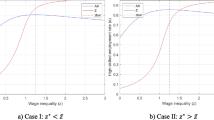Abstract
This paper considers the effect on productivity growth of the wage moderation policy embarked upon in the Netherlands starting in 1982. The paper describes how the effect depends on the macroeconomic importance of the hold-up problem that results from specificity in factor markets. The analysis is based on a vintage model of capital with embodied technology. In a traditional vintage model, a decline in wages relative to cost of capital will delay scrapping and postpone new investment, thus reducing productivity growth in the medium term. In a recent version of the vintage model, where the specific production relationship between capital and labour gives rise to problems associated with appropriability of rents, institutionalised wage moderation will increase new investment and improve productivity. A preliminary analysis of micro-level data of industrial firms does not yet lead one to reject the important role of specificity.
Access this chapter
Tax calculation will be finalised at checkout
Purchases are for personal use only
Preview
Unable to display preview. Download preview PDF.
Similar content being viewed by others
References
Abbring, J.H. and P.A. Gautier (1997), “Gross Job Flow in Netherlands Manufacturing: A Panel Data Analysis,” mimeo.
Bartelsman, E. J. and M. E. Doms (2000), “Understanding Productivity: Lesson from Longitudinal Microdata, ”Journal of Economic Literature,forthcoming.
Bartelsman, E.J., G. van Leeuwen and H. Nieuwenhuijsen (1998), “Adoption of Advanced Manufacturing Technology in the Netherlands,” Economics of Innovation and New Technology 6, pp. 291–312.
Bovenberg, L. A. (1997), “Dutch Employment Growth: An Analysis,” CPB-report 2 (2), 1624.
Broer, D.P. (1996) On The Theory of Investment in Vintage Capital Models, Tinbergen Institute Discussion Paper 96–92/4, Tinbergen Institute.
Caballero, R.J. (1997), “Aggregate Investment, A 90’s View,” May, mimeo.
Caballero, R.J. and M.L. Hammour (1996), “The Macroeconomics of Specificity”, NBER Working Paper Series 5757, September.
Caballero, R.J., E.M. Engel and J.C. Haltiwanger (1995), “Plant-level Adjustment and Aggregate Investment Dynamics,” in Brookings Papers on Economic Activity Washington, D.C., pp. 1350–1368.
Cooper, R, J. Haltiwanger and L. Power (1994), “Machine Replacement and the Business Cycle: Lumps and Bumps,” mimeo.
CPB (1992), FKSEC: A Macro-econometric Model of the Netherlands, Nijmegen: Stenfert Kroese.
CPB (1997), Challenging Neighbours, Berlin: Springer Verlag.
Davis, S., J. Haltiwanger and S. Schuh (1996), Job Creation and Job Destruction, Cambridge, MA: MIT Press.
Doms, M. E. (1993), “Inter Fuel Substitution and Energy Technology Heterogeneity in U.A. Manufacturing,”discussion paper CES 93–5, U.S. Bureau of Census, Center for Economic Studies, March.
Dunne, T. and M. Doms (1993), “An Investigation into Capital and Labour Adjustment at the Plant Level,” mimeo, Center for Economic Studies.
Dunne, T., M. Roberts and L. Samuelson (1988), “Patterns of Firm Entry and Exit in U.S. Manufacturing Industries,” RAND Journal of Economics 19, pp. 495–515.
Fare, R. (1994), “Productivity Growth, Technical Progress, and Efficiency Change in Industrialized Countries,” American Economic Review 84, pp. 66–83.
Jorgenson, D., F. Gollop and B. Fraumeni (1987), Productivity and U.S. Economic Growth, Cambridge: Harvard University Press.
Kleinknecht, A.H. (1994), “Heeft Nederland een loongolf nodig?,” Economisch Statistische Berichten, January, pp. 5–24.
Koopmans, C., (1997), “NEMO: CPB’s new energy model,” CPB-report, vol. 2 (2), pp. 34–38.
Malcomson, J.M. (1997), “Contracts, Hold-up and Labour Markets,” Journal of Economic Literature 35, pp. 1916–57.
McGuckin, R.H. (1995), “Establishment Microdata for Economic Research and Policy Analysis: Looking beyond the Aggregates,” Journal of Business and Economic Statistics 13, pp. 121–26.
Author information
Authors and Affiliations
Editor information
Editors and Affiliations
Rights and permissions
Copyright information
© 2000 Springer Science+Business Media New York
About this chapter
Cite this chapter
Bartelsman, E.J. (2000). Productivity and Specificity in Factor Inputs. In: van Ark, B., Kuipers, S.K., Kuper, G.H. (eds) Productivity, Technology and Economic Growth. Springer, Boston, MA. https://doi.org/10.1007/978-1-4757-3161-3_8
Download citation
DOI: https://doi.org/10.1007/978-1-4757-3161-3_8
Publisher Name: Springer, Boston, MA
Print ISBN: 978-1-4419-5003-1
Online ISBN: 978-1-4757-3161-3
eBook Packages: Springer Book Archive



